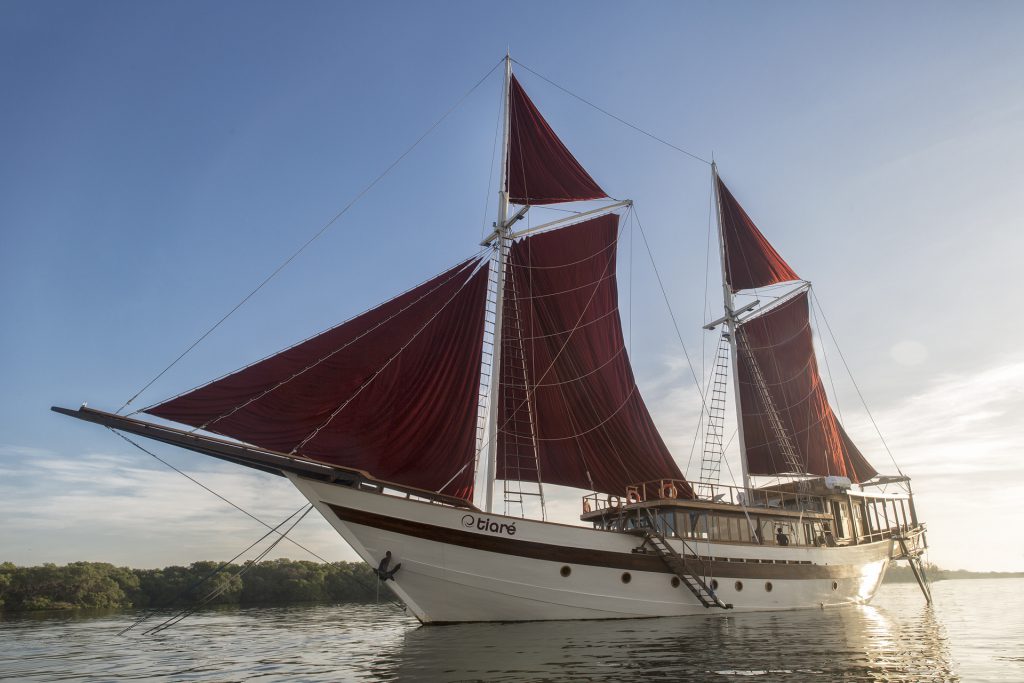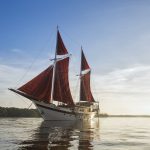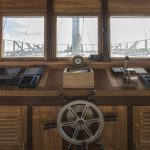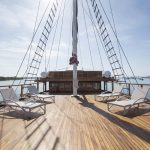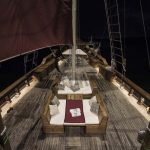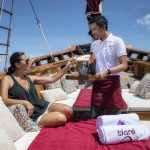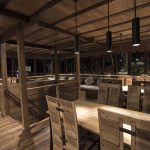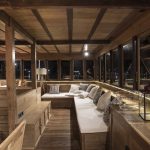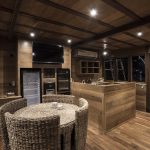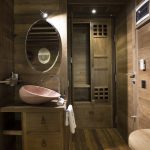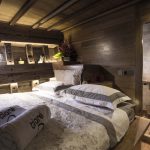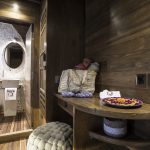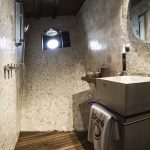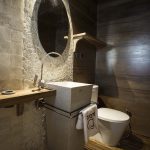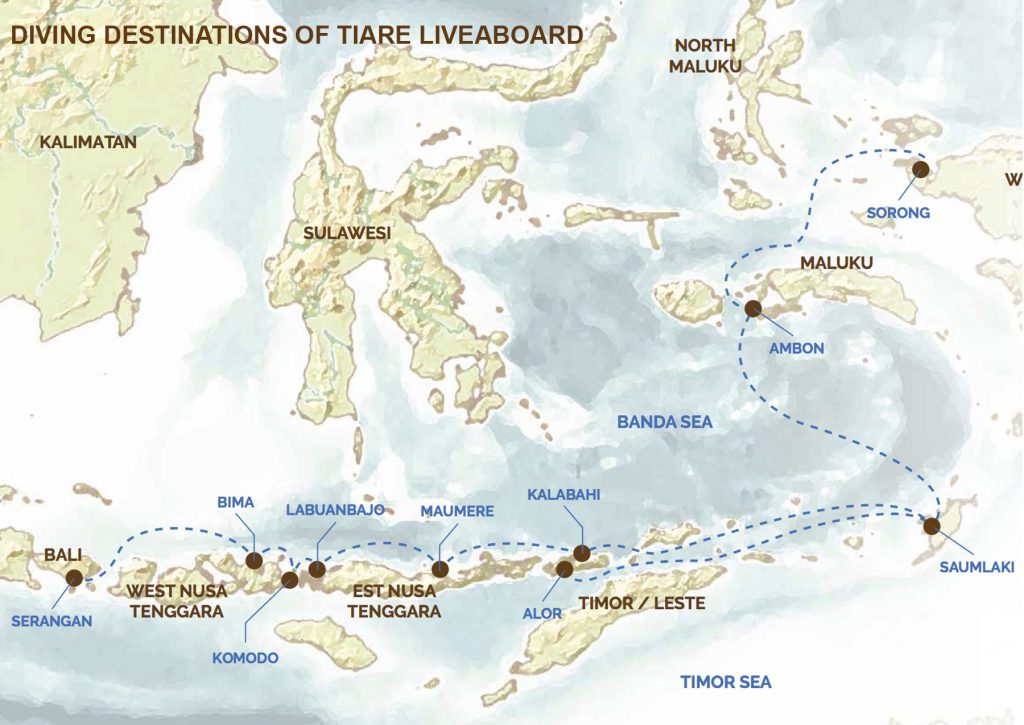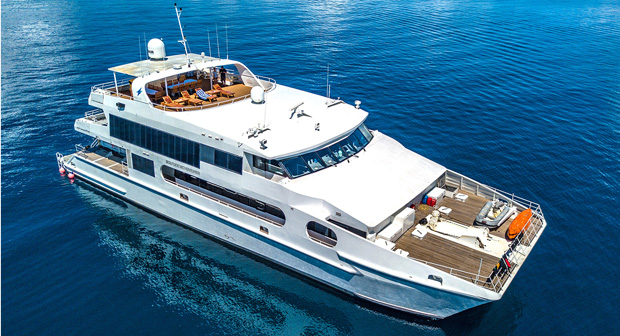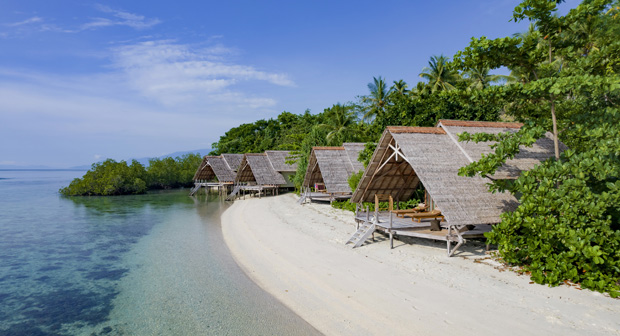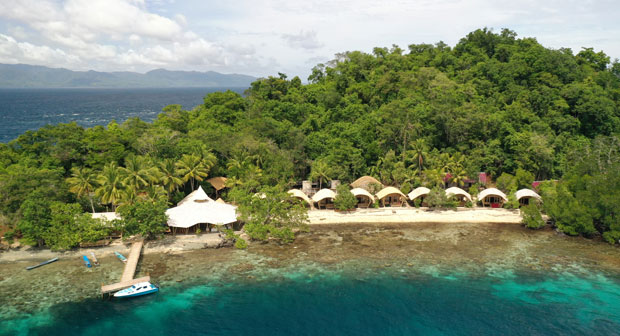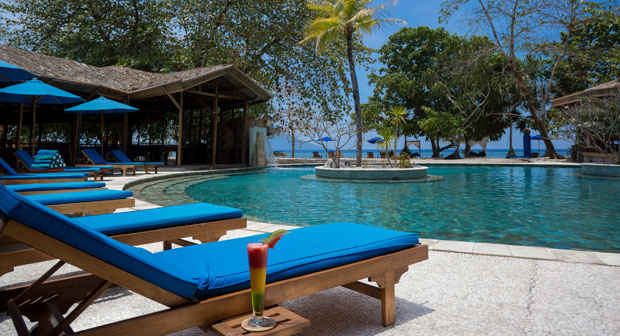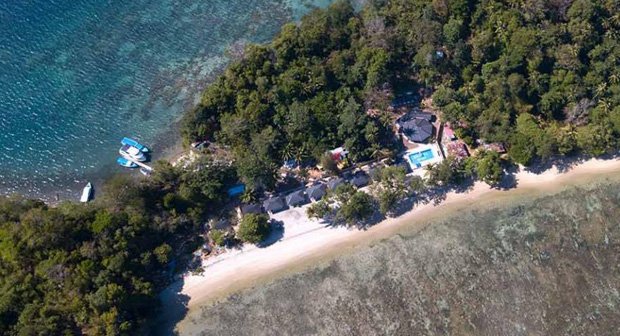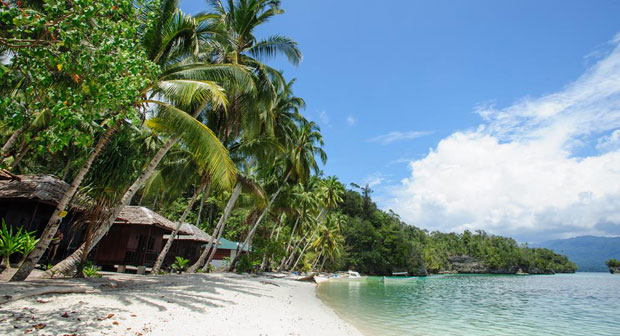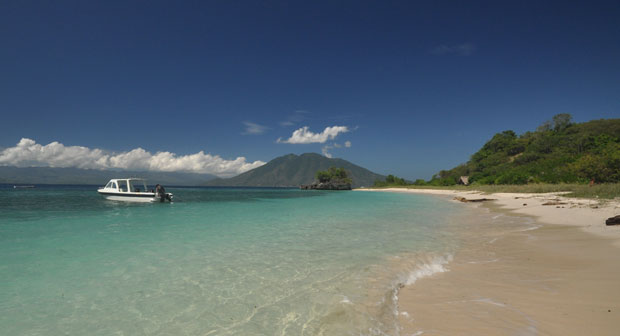Tiaré – Komodo, Alor, Bandasee, Raja Ampat + Triton Bay
Die Tiaré ist eine 36 m lange Luxus-Segelyacht im Phinisi-Stil, die bis zu 14 Gäste in 6 Kabinen aufnehmen kann. Das exklusive Liveaboard fährt ganzjährig Tauchsafaris in fast ganz Indonesien.
Preis: ab 2.650,- €
6 Tage/5 Nächte, Komodo Süd, ab/bis Labuan Bajo, Ü/VP Doppelkabine, inkl. Tauchen (Preis pro Person, ohne Flüge)
Beschreibung Tiaré
 Die Tiaré ist ein exklusiver Zweimaster im Stil eines Phinisi-Segelschoners, mit dem Tauchsafaris in fast ganz Indonesien angeboten werden, z.B. nach Komodo, Alor, in die Bandasee oder nach Raja Ampat. Selbst so exotische Ziele wie die Forgotten Islands oder Triton Bay stehen auf dem Programm.
Die Tiaré ist ein exklusiver Zweimaster im Stil eines Phinisi-Segelschoners, mit dem Tauchsafaris in fast ganz Indonesien angeboten werden, z.B. nach Komodo, Alor, in die Bandasee oder nach Raja Ampat. Selbst so exotische Ziele wie die Forgotten Islands oder Triton Bay stehen auf dem Programm.
Das Schiff wurde 2013 gebaut und 2017 umfassend modernisiert und steht unter französisch-italienischer Leitung. Die 36 m lange Tiaré bietet Platz für 14 Gäste in 6 klimatisierten Doppel- oder Dreierkabinen, welche exklusiv ausgestattet sind und über individuell regelbare Klimaanlagen, reichlich Stauraum und private Bäder mit Dusche/WC verfügen. Jeder Gast erhält ein Reiseset für Landgänge, bestehend aus Moskitospray, Hut, Handtuch und Sonnenlotion.
Der geräumige klimatisierte Salon mit Restaurant und Lounge, inkl. TV und Bibliothek befindet sich auf dem Hauptdeck. Die Bordküche bietet schmackhafte asiatische und europäische Gerichte, zu denen erlesene Weine serviert werden. Softdrinks, lokales Bier, Wasser, Kaffee/Tee sind an Bord inklusive, sowie ein Glas Rot- oder Weißwein vor dem Essen oder zur Happy Hour.
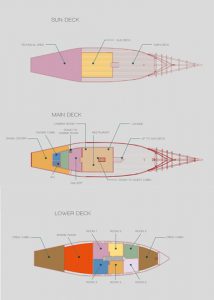 Die Tiaré bietet ein exklusives Taucherlebnis mit einer luxuriösen Ausstattung, wie einem Spa inkl. Whirlpool und einer gemütlichen Lounge im überdachten Außenbereich. Ein großes Sonnendeck mit mehreren Liegestühlen lädt zum Relaxen und Sonnenbaden ein.
Die Tiaré bietet ein exklusives Taucherlebnis mit einer luxuriösen Ausstattung, wie einem Spa inkl. Whirlpool und einer gemütlichen Lounge im überdachten Außenbereich. Ein großes Sonnendeck mit mehreren Liegestühlen lädt zum Relaxen und Sonnenbaden ein.
Das Schiff operiert unter höchsten Sicherheitsstandards, z.B. wird mit einem ENOS-Sicherheitssystem getaucht. Zwei schnelle 6 m Tauchboote mit je 90 PS stehen für Tauchausfahrten bereit. Getaucht wird mit 12 + 15 L. Aluflaschen (DIN/INT) bis zu 3 Mal täglich (32 % Nitrox optional), plus Nachttauchgänge.
Ein separater Kameraraum bietet genügend Stauraum und Lademöglichkeiten (220 V. Eurosteckdosen) für elektronische Geräte. Spülbecken für Kameras und Lampen sind vorhanden. Im Tauchbereich gibt es 2 Warmwasserduschen.
Um die Gäste kümmert sich eine professionelle 15-köpfige Crew, darunter 2 Köche, 2 Tauchguides und ein italienischer Cruise Director, der auch Tauchlehrer ist. Sprachen an Bord: Englisch, Französisch, Italienisch, Spanisch und Indonesisch.
Kabinenfotos + Ausstattung Tiaré
- Tiaré – unter Segel
- Tiaré – Außengang
- Tiaré – Cockpit
- Tiaré – Sonnendeck
- Tiaré – Außenbereich
- Tiaré – Service Frontdeck
- Tiaré – Service Restaurant
- Tiaré – Salon/Restaurant
- Tiaré – Lounge
- Tiaré – Bar
- Tiaré – Twin-Kabine
- Tiaré – Twin-Kabine, Bad
- Tiaré – Doppel-Kabine
- Tiaré – Kabine, Accessoires
- Tiaré – Twin-Kabine
- Tiaré – Kabine, Bad
- Tiaré – Kabine, Bad
Spezifikation/Ausstattung Tiaré
| Year built | 2013-2016 |
| Type | Phinisi – traditional wooden 2 mast top sail schooner |
| Length over deck | 36,50 m |
| Length overall | 45,62 m |
| Beam | 9 |
| Draft | 3 |
| Cruising speed | 10 knots |
| Engines | Yanmar Turbo Diesel 500 PS |
| Fuel Capacity | 11.000 l |
| Generators | 2x Yanmar 60 kw |
| Water Storage | 10.000 l |
| Water Makers | 2x 3.000 l fresh water a day |
| Voltage | 220 V. charging station, but also 110 V. is available |
| Crew | 1 captain, 1 co-captain, 1 officier 3 engineers 1 chef, 1 sous chef 1 room mate, 1 lounge mate 1 cruise manager/diving instructor 2 dive master/guides 2 diving crew |
| Cabins | 4 king size, 2 twin, 2 cabins for families are provided with 1 single bed fitted |
SAFETY EQUIPEMENT:
- 12 beacon ENOS plus, 1 receiving station for rescue*
- 30 life jackets
- 2 life-raft carrying 20 people each
- 1 oxygen tank on main boat
- 1 oxygen tank on diving boat + emergency kit
- Fire detector system
- 1 hydrant
* The beacon will be installed on each customer’s BCD, while the receiving station is on the diving boat. If a customer has problems on the surface, he may activate the beacon and the receiving station reports his position.
Tiaré Routen
Die Tiaré fährt u.a. folgende Routen, weitere Tourbeschreibungen auf Anfrage*:
Komodo Süd, 5 Nächte, ab Labuan Bajo/bis Bima
Day 1:
After boarding Tiaré in Labuan Bajo you will enjoy a tour of the boat and settle in with breakfast on the boat. Sailing to Sabolan Kecil you will have an afternoon dive before moving on to Sebayur Island for a night dive at the mini wall.
Day 2:
Wake up to the beautiful sights of the straits between the islands of Komodo and Rinca. You will dive here at the stunning Manta Reef (Karang Makassar) and the spectacular Batu Bolong, where you will see an incredible amount of coral and tropical fish. Rest and have lunch on board before an afternoon dive at Three Sisters; 3 underwater ridges with massive steps, and towers of stone, caves and overhangs covered in soft corals. Expect to see nudibranchs , frogfish and larger marine life like reef sharks and bumphead parrotfish. Your third dive of the day will be a night dive in Padar. Water temperatures at these sites can drop to around 20°c, so be prepared for the possibility of chillier dives. You might also notice the water is greener here than other areas. However, this means there are far more nutrients in the water, which in turn means incredible biodiveristy!
Day 3:
On day 3 you will have 4 dives off Nusa Kode Island, where you’ll see some of the most incredible marine creatures in the archipelago. During the day you’ll dive at Canninbal Rock, which has often been listed as one of the top 10 dive sites in the world! With its sand slopes, rocky areas and a plateau covered in marine life, you can expect to see hard and soft corals, sponges, tube anemones, and a huge variety of nudibranchs. Yellow Wall at southern entrance to Horseshoe Bay is your next stop, where you will see the yellow and orange corals that give the site its name. This drift dive allows you to slowly take in all the ladybugs and nudibranchs covering the wall. Entering in to the bay Boulders is home to resting rays and sometimes even hiding nurse sharks. Head back to Tiaré for a rest before a shallow night dive in Torpedo Bay (sometimes called Torpedo Alley). This site is named after the torpedo rays that are found here. You can also expect seahorses, coconut octopus, squid and the odd bobbit worm burrowed into the volcanic black sand.
Day 4:
Day 4 has another 4 incredible dives in store for you: weather permitting of course. This morning you’ll be south of Komodo Island at Manta Alley and German Flag. Manta Alley is in Tora Langkoi Bay and is the most popular dive for spotting the majestic manta rays. There is also a possibility of spotting mantas at German Flag, as well as Malabar groupers, schools of potato cod, red snapper, surgeon fish. In the afternoon you will dive Tanjung
Lehoksera or Batu Gajah depending on the weather conditions. At night discover the wreck of a 100-foot wooden Pinisi boat.
Day 5:
A more restful day 5 includes 2 dives at Pulau Hantu and Pantai Merah (Pink Beach) off of Komodo Island. Pink Beach is famous for not only its beautiful pink sand, but its mini wall in the middle of the reef where the crevices make the perfect home for glassfish, nudibranchs, frogfish, crocodilefish and scorpionfish. In the sandier area opposite the wall juvenile harlequin sweetlips and mandarin fish live. After so many amazing dives it’s time to meet the magnificent Komodo dragons on their own turf. Tour the island before heading back to the boat and sailing overnight to Bima.
Day 6:
After breakfast on board it’s time to check out and leave the Tiaré behind. Departing from Bima.
Note: This itinerary may vary depending on weather conditions, flight timetables and other unforeseen circumstances.
Komodo Nord, 6 Nächte, ab Bima/bis Labuan Bajo
Day 1:
Your journey begins when you board the stunning Tiaré in Bima, on the island of Sumbawa. After settling into your accommodation you’ll get ready for some world-class muck diving off the coast of Bima in the Bay. After checking the diving conditions you may dive Bethlehem or Tanjung Batu Putih, 2 other great muck diving sites. A night dive will also be chosen depending on the water conditions.
Day 2:
Waking up you’ll be treated to views of the island of Sangeang off the northeast coast of Sumbawa. This island is home to Gunung Api, one of Indonesia’s many active volcanoes. The volcanic activity here has created the perfect conditions for a number of excellent dive sites with healthy reefs of soft and hard corals as well as many types of anemones. You’ll take 4 dives around the island, including Bubble Reef with underwater vents emerging from the black sand, Critter Creek and Pohon Merah. This are great dives for finding creatures hiding in the black sand. Bontoh Reef on the west side of the island is an excellent final dive of the day with the fabulous sunset.
Day 3:
It’s another 4 dive day, this time off Gili Banta, an island between Sumbawa and Komodo. In the morning you’ll dive GPS point, Highway to Heaven, and Small World. GPS Point and Highway to Heaven are challenging dives as currents can be strong, but the payoff is the possibility of seeing sharks, schools of barracuda, dogtooth tuna and more larger predators. Small World is a more sheltered dive where you might find stargazers buried in the soft sand.
After lunch head under water again for a beautiful drift dive at Golden Passage followed by a night dive off Gili Lawa Laut.
Day 4:
On day 4 you will dive some challenging sites off Gili Lawa Laut. Crystal Rock (named for the rock jutting out from crystal blue water) and Castle Rock both boast a wide variety of very healthy corals and an impressive array of marine life. Couldron (sometimes called Shotgun) and Gili Lawa Laut Lighthouse are two of the other thrilling dives in this area and can be dived in the evening or at night. Here you might see crocodilefish, lionfish, sometimes eagle rays and reef sharks and even manta rays.
Between dives you’ll have the chance to trek to the highest point of Gili Lawa Laut to see the gorgeous views over the Komodo-Flores channel.
Day 5:
Today you’ll be diving off Komodo Island where currents can be quite strong. Dives must be timed in accordance with tides and weather conditions so there are a number of dive sites you may visit. Takat Makassar Reef, Batu Bolong and Tatawa Kecil are all stunning dives with soft and hard corals. You’ll have the chance to see white and black tip reef sharks, manta rays, turtles, giant trevally, snapper in various environments, from shallow reefs to canyons and caves. Dive at night at the mini wall at Pulau Sebayur where you should Look for leaffish, ghost pipefish and nudibranchs.
Day 6:
Get up early and dive at Sebayur Besar and then Batu Tengah. Batu Tengah is right in the middle of the Komodo National Park and slopes into a stunning coral garden. Divers often see turtles, cuttlefish, white tip reef sharks and large groups of Napoleon wrasse and snapper here.
In the afternoon, the outgoing group visit island of Rinca to meet Komodo dragons up close and personal, while the group staying for the longer cruise carry on to a night dive in Wainilu.
Day 7:
After breakfast on board it’s time to check out and leave the Tiaré behind. Departing from Labuanbajo.
Note: This itinerary may vary depending on weather conditions, flight timetables and other unforeseen circumstances.
Alor & Lembata, 7 Nächte, ab/bis Kalabahi
Day 1:
Board the stunning Tiaré, your home for the next 7 nights, in Kalabahi, Alor Island and be ready to depart around 12pm.
Day 2:
After getting settled on the boat and orientation, you’ll have an easy first day in Kalabahi Bay. Mucky Mosque and Rocky Church are two of the excellent muck dive sites we will visit and you might even see the Rhinopias, master of camoflague. Diving at night means you’ll also get the unique opportunity to see strange creatures even more incredible than the ghost pipefish, soft coral crabs, frogfish, wunderpus and mimic octopus, snake eels, sea moths, sand divers and many other remarkable creatures found during the day.
Day 3:
The Alor/Pantar Strait has a vast rage of sites; from shear drop-offs, jutting rocks, and shallow reefs where colourful corals can be seen in their full glory. You will see the famous diving villagers of Here you can see Pura Island diving with only homemade googles fashioned from wood and the ends of glass bottles.
Diving during these days at sites like Yan Village, Clown Valley, large pelagics pass through the Pantar Strait and if we hear of whales, dolphins or sunfish, we’ll have the chance to go hunting for them in the tenders and snorkel if we find them.
Day 4:
Dive today at Beangabang in the famous Lembeh Strait. This is a protected bay where the water is a little cooler and night dives are incredible for macro life. Recent spottings here are: blue ringed octopus, coconut octopus, frog fish, rhinopias of various kinds, wonderpus, frogfish and ghost pipefish.
Day 5:
Off the southern coast of Pantar and Pulau Kambing the marine life is plentiful thanks to upwellings and swells from deep under the sea. Because of this large pelagics are often seen feeding. There are a number of other sites around these islands that we will possibly dive and see all kinds of incredible marine life.
Day 6:
More big fish and possible sharks await arounf Alor and Pura Islands. The water is beautifully clear in this area with visibility up to 30 metres but the currents can be strong, so these dives can be challenging. The challenge is all worth it though for the whitetips and huge grey reef sharks, tuna, grouper, sunfish, manta rays and even whalesharks and pilot whales if you’re lucky.
Day 7:
Back to the great muck diving in Kalabahi Bay, you’ll dive twice in the morning and then have a wonderful land excursion to a traditional village on the island of Alor.
Day 8:
After a last breakfast and goodbyes with the crew it’s time to disembark in Kalabahi.
Note: This itinerary may vary depending on weather conditions, flight timetables and other unforeseen circumstances.
Raja Ampat, 8 Nächte, ab/bis Sorong
Day 1:
After boarding Tiaré you’ll embark on the journey of a lifetime about 12 o’clock from Sorong into the waters of Raja Ampat. Raja Ampat means ‘Four Kings’, referring to the 4 main islands of Waigeo, Salawati, Batanta, Misool (there are actually over 1,500 small islands). Most of Raja Ampat is protected by the Indonesian government so you can expect pristine corals and an abundance of sea life. Of course visibility can vary depending on the weather conditions, but water temperatures stay around 27-30° C.
Day 2:
The first two dives of the day are at Manta Sandy, well-known to divers as it is one of the most consistent spots for finding congregating mantas. It is easy to spend a whole dive observing these majestic animals as they somersault through the water while being cleaned by several species of wrasse and even butterfly fish. They also come to feed on plankton carried along by the currents, so can be seen on the surface as well. With a bit of luck you’ll witness the unforgettable sight of a ”manta train”, where half a dozen or more mantas glide around feeding. Your afternoon and night dives are at Arborek Jetty. In the shallows the jetty posts are covered in soft corals and further down you’re likely to see pipefish and cuttlefish. Watch local children jumping off the jetty and smiling for your cameras and even join in the fun! On the reef giant clams nestle in the pulsing soft corals and at search for blue ringed octopus, hermit crabs, skeleton shrimp and flatworms. At night you might even be able to hear toadfish croaking. Between dives you will have the chance to visit the village on Arborek Island to discover the very traditional way of life these island people live. Bring along some little presents like writing or colouring supplies or hair accessories for the kids of the village and you’ll see them light with smiles like you’ve never seen before.
Days 3, 4 + 5:
On days 3, 4 and 5 you’ll be in the Gam or Penemu areas diving the many extraordinary sites there.
Between Gam and Yanggelo Islands, Citrus Ridge offers gorgeous white sand contrasting the yellow and orange corals that teem with glassfish, sweetlips and batfish. Moving on to Takat Yanggelo (north & south) you’ll see similar species as well as huge schools of snappers, barracuda and fusiliers. Dive with black and white tip sharks at Woebegone and also have a search for the tricky blue ringed octopus. Still between the 2 islands, Mangrove Ridge is a ridge extending out from Tangelo covered in black corals and huge sea fans. Explore the shallows of the mangroves where many species of juvenile fish, cardinal fish and archerfish hide in the roots of the trees. You’ll then head to Penemu, an island west of Waigeo with a selection of dives sites, the most famous being Melissa’s Garden. Shallow hard coral reefs here are home to hundreds of anthias dance and also sea snakes. The long, submerged seamount at Takat Penemu has a beautiful coral garden sloping to where where schools of fish hang out in the currents. Have a peek inside the large cup corals where Wobbegong sharks like to sleep, and visit Penemu Wall, My Reef and Harto’s Reef for more incredible sights. At Penemu Island you will also have the chance to stop and climb to the highest point of the island to admire the entire lagoon from above.
Day 6, 7 + 8:
The Dampier Strait, located between Waigeo and Batanta Islands is known to have some of the most nutrient-rich and spectacular diving in Raja Ampat. The currents passing through the strait make for the perfect diving situation and you can expect to see incredible corals housing just about every species of fish as well as prized macro subjects like the recently discovered Pontohi pygmy seahorse.
Sardine Reef is a popular dive spot, which ironically isn’t home to any sardines. However, you will see a stunning reef covered in huge sea fans, soft corals, enormous orange elephant ear sponges and schools of fusiliers, surgeonfish, trevallies, rainbow runners, sweetlips and bannerfish. In fact, at this site the fish are so abundant you may hear the unique sound of “fish thunder” – the surprisingly loud sound of a large number of fish moving in synchronisity. Other dives in Dampier Strait include Chicken Reef, Kerupiar Island and Friwin Bonda. Dives over these 3 days will also include Cape Kri, which holds the impressive record of 374 fish species identified during one 90-minute dive, Otdima Reef and Blue Magic. This is a submerged seamount where you may encounter giant manta rays. Saonek Jetty or Jembeser Jetty are ideal for night dives; you’ll have the chance to see bobtail squid, octopus, stargazers, ghost pipefish, toadfish and lots of nudibranchs at these sites. If you’d also like to see some of the incredible animal life above water, take a hike in the jungle to see Papua’s famous Birds of Paradise. There will be an extra charge for this tour and it is dependent on the weather and all of the guest’s preferences. Depending on the weather conditions and flight times the next day, the last full day of the cruise will include 1 or 2 dives at one of the above sites. After the dives you’ll cruise back to Sorong.
Day 9:
Say goodbye to your crew over one last Tiaré breakfast and then head on to the airport in Sorong for your outbound flight.
Note: This itinerary may vary depending on weather conditions, flight timetables and other unforeseen circumstances.
Raja Ampat & Triton Bay, 11 Nächte, ab Sorong/bis Kaimana
Day 1:
Raja Ampat means ‘Four Kings’. In an archipelago of over 1,500 small islands there are four main islands or ‘kings’– Waigeo, Salawati, Batanta, Misool. The majority of Raja Amat is a Marine Protected Area. These islands usually experience varying visibility depending on the weather conditions and warm water around 27-30C (81-86F).
Days 2-5:
Misool Island, one of the ‘Four Kings’ is in the south of Raja Ampat and is surrounded by a multitude of smaller islands to the southeast. The sites in this area are famous for their colourful soft corals and sea fans swaying in the warm waters of the reef. You’ll dive for 3 days in the Misool area, including Boo Windows, Yuliet and Romeo, Fiabecet, Wayilbatan, Daram Area, Pele and Sagof/Wagmab/Farondi Areas. You’ll encounter an incredible range of sea life during these dives, from turtles, reef sharks, pygmy seahorses, mantas, barracudas and everything in between! In this area you also may have the opportunity to take a ride to a pearl farm and also explore caves and rock formations.
Day 6:
30 miles south of Misool is a beautiful archipelago where we’ll dive off of Pualu Koon or Pulau Pisang. The corals are extremely healthy in this remote area and are full of life. You’ll see giant elephant ears, swirling schools of a wide variety of fish, mantas and turtles.
Day 7:
Take a trip on land in the morning to an incredible waterfall and enjoy the stunning above-water scenery. There will be plenty of photo opportunities, so don’t forget your camera! In the afternoon take a relaxing dive near Momon Bay.
Day 8:
Triton Bay is the next stop and is one of the most spectacular dives you’ll experience in Raja Ampat. The diversity of the coral and marine life are heaven for divers and, thanks to very little fishing in this area, are healthy and plentiful. Your first dive here will be at 7th Heaven where you will probably see giant trevalies, barracuda, giant turtles, grunts, and even mantas and walking sharks. GT Rock, which is named after the multitude of giant trevallys found there is a beautiful dive as well. Swim with the hundreds of grunts, red snappers, huge sweet lips and tuna that feed around the rock.
Day 9:
Still in Triton Bay, we’ll continue to discover how extraordinary the area’d biodiversity really is. Larry’s Heaven honors the legendary Larry Smith, who spent years diving and studying the marine creatures of Indonesia. His very last dive was in this area, which boasts the world record for having the most different species in one area. Fields of black coral are home to such densely packed biodiveristy you may think you’re in the middle of an incredible dream. Wrass, gobies, grouper, bump heads, turtles, and millions of fusiliers will surround you as you glide through the water…and that’s just the beginning of the list.
Days 10 + 11:
Spend 2 days diving around Aiduma, Orembate and Faukate (Lauzaro). These are incredible sites for searching for macro species and are especially exciting for dive photographers. You’ll find an incredible variety of reef fish, including schools of large blurring angelfish, clownfish, striped angelfish and lionfish. You might also spot dolphins enjoying leaping and dancing through the waves.
Day 12:
After a last breakfast and goodbyes with the crew it’s time to disembark in Kaimana.
Note: This itinerary may vary depending on weather conditions, flight timetables and other unforeseen circumstances.
Forgotten Islands & Bandasee, 11 Nächte, ab Saumlaki/bis Ambon
Saumlaki in the Tanimbar Islands group of West Maluku serves as the gateway to a group of remote islands known as the Forgotten Islands. This group of islands stretches for almost 1000 kilometres from Timor across the Banda Sea to West Papua. Liveaboard boats are the only way to experience the Forgotten Islands and Saumlaki is generally the point of departure. There are endless diving opportunities and some islands and dive sites are so remote you will wonder if anyone has ever seen what you are seeing. The visibility in the Forgotten Islands is generally excellent, especially arounf the islands formed by volcanic activity. Sites can reach from shallow much dives to over 40 meters deep and water temperatures stay around 27°c – 30°c.
On a liveaboard cruise on Tiaré you can expect to dive 3 or 4 times a day depending on the weather conditions and currents. Some of the most famous dive sites you will visit are Nil Desperandum, Wetar, Nunukae, Leti, Babar, Pantar, Palu and Nusa Laut. We are also open to creating a tailor-made itinerary so you get to do the type of diving you love most. You’ll have the chance to dive rugged rocky outcrops, spectacular coral reefs and walls with hard and soft corals, black sands where smaller creatures bury themselves and of course huge pelagic species like white and black tip reef sharks, hammerheads, barracuda, majestic manta rays and gigantic groupers. There is no shortage of sea life to be explored around the Forgotten Islands and you will get to see more than you could ever imagine while on a liveaboard cruise on the luxury Tiaré.
Getting to Saumlaki
Saumlaki is very remote and can take a number of flights to reach. The easiest way is usually flying from Jakarta to Ambon and then on to Saumlaki where Tiare will be waiting for you. You can choose to return to either Saumlaki or Ambon at the end of your cruise.
Note: This itinerary may vary depending on weather conditions, flight timetables and other unforeseen circumstances.
* Tourverläufe sind beispielhaft und können sich aufgrund von Seegang, Wetter oder besonderen Wünschen der Taucher ändern
Preise Tiaré
Preise* pro Person/Nacht, inkl. Vollpension + Tauchen:
| Doppel- oder Dreierkabine | 570 € |
| Doppel- oder Dreierkabine, nur Komodo | 530 € |
| Zusatzperson, nur Dreierkabine | 320 € |
* Preise auf USD-Basis, Änderungen möglich. Aufpreis Einzelbelegung 300 € pro Nacht
-> Spezielle Konditionen für Gruppen: 12 + 2 Personen gratis
Eingeschlossene Leistungen:
- Unterkunft in AC-Doppel- oder Dreierkabine mit eigener Dusche/WC, inkl. Vollpension + Getränke (inkl. Wasser, Soft Drinks, Säfte, Balinesischer Kaffee & Tee)
- 3 Tauchgänge pro Tag + 1 Nachttauchgang, je nach Wetterbedingungen und Tourverlauf (kein Tauchen an An- und Abreisetagen)
- Alle Tauchgänge inkl. Boot, Guide, Flasche/Blei (bei eigener Ausrüstung)
- gratis WLAN, Wäschedienst, Benutzung von Seekajaks- + SUPs
- Transfers vom Zielflughafen zum Schiff und zurück
Extrakosten*:
- Nationalpark-/Hafengebühren + Treibstoffzuschlag, 120-250 USD pro Person (je nach Tour und Entfernung)
- Alkoholische Getränke an Bord & Espresso
- Nitrox optional 15 USD pro Person/Tag
- Massagen, Tauchkurse, Trinkgelder für Crew
- Leihausrüstung auf Anfrage
* Gebühren und Zuschläge können sich kurzfristig ändern
Termine & Verfügbarkeiten
HP/VP=Halb-/Vollpension, HS/NS=Haupt-/Nebensaison, T/N=Tage/Nächte, TG=Tauchgänge

